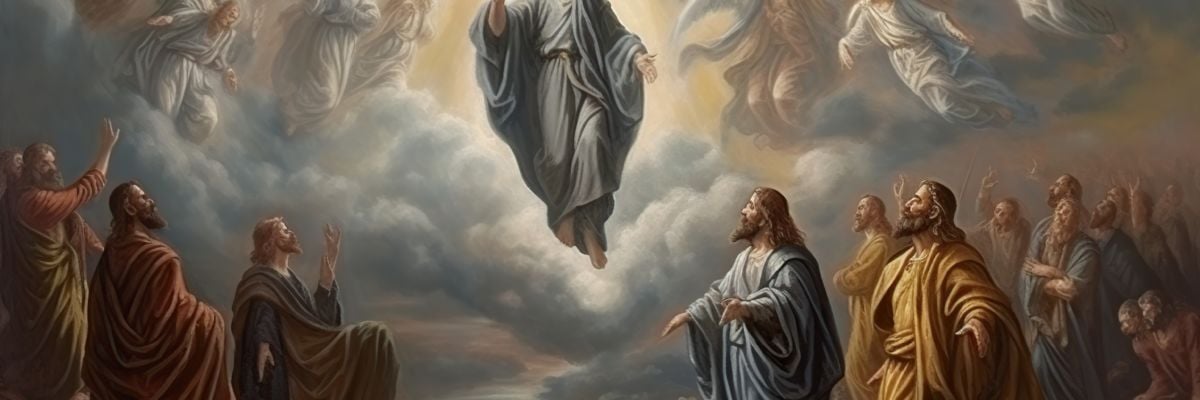
A novena is a popular devotion that involves a series of prayers over nine consecutive time periods (usually days, sometimes weeks), usually focused on a particular event or person and often involving petition for a specific intention.
Why are we talking about novenas today, on Ascension Thursday? Because today marked the primordial “novena” that subsequently shaped this devotion in the Church.
On the fortieth day after his resurrection, before ascending into heaven, Jesus told his apostles not to leave Jerusalem, but to await the “promise of my Father,” assuring them that “in a few days, you will be baptized with the Holy Spirit” (Acts 1:4-5). And that is what they did (v. 12), praying (v. 14) and tending to the life of the Church by electing Matthias to replace Judas in the Apostolic College (vv. 15-26).
Jesus was unspecific about time. When the apostles make one last pitch for knowing whether Jesus would restore Jewish supremacy, he tells them, “It is not for you to know the times or seasons that the Father has established” (v. 7). Even as regards the “promise of my Father” (a far greater gift than “restoring the Kingdom to Israel”), Jesus tells them to “wait” in the Holy City without saying how long.
They did . . . for nine days of preparation until the Holy Spirit descended.
(That’s why I applaud the minority of American dioceses that, after 1999, refused to transfer the Solemnity of the Ascension from its traditional place on the fortieth day after Easter—a Thursday—to the following Sunday, ostensibly for pastoral reasons. Jesus told his apostles to wait, no matter how long it took. Losing that awareness that we wait by the Father’s time schedule, not our “pastoral convenience” is, in my judgment, a spiritual problem.)
Acts makes clear these days were spent “in prayer.” The apostles were promised a great gift, and they recognized their need to prepare for him.
On the model of the apostles and their nine days of prayer, one of the earliest novenas—the Novena to the Holy Spirit—emerged. One form focused on each of the days first on the Holy Spirit himself, then each of his seven gifts (counsel, piety, fortitude, wisdom, understanding, knowledge, fear of the Lord) and his twelve fruits.
In December 2001, the Congregation for Divine Worship and Discipline of the Sacraments issued a “Directory on Popular Piety and the Liturgy.” In its section on Pentecost, it speaks of “the Pentecost Novena” (which is essentially the Novena to the Holy Spirit), recommending that it be observed with “the solemn celebration of Vespers” (Evening Prayer) or at least “the liturgical themes of the days from Ascension to the Vigil of Pentecost” (155).
Over the centuries, various novenas emerged in the Church’s history, often connected with specific feasts. (For example, there is the “Christmas Novena” from December 16 to 24, which is also marked in the liturgy by a shift in Advent focus from the eschatological [“Second Coming”] to the more immediate commemoration of Jesus’ historical birth in Bethlehem. That novena also largely overlaps with the “O” Antiphons in Vespers.) Although many novenas came to be associated with preparation for feasts (especially Marian feasts), over time, they also turned to focus on invoking particular patrons to seek assistance for a person’s intentions. Popular twentieth-century examples of the latter were novenas to the Miraculous Medal, Our Lady of Perpetual Help, St. Gerard Majella (especially for expectant mothers), and St. Jude Thaddeus (the patron of “hopeless causes”). If we look at church bulletins from the 1920s to the 1970s, it’s likely we’ll see at least one such weekly novena in the average American parish.
Such examples of popular piety were often casualties of the post-Vatican II period, where a certain generation of clergy considered novenas folkloristic relics that “detracted” from “proper liturgical piety” in the parish. Some priests simply stopped them. Others declined to officiate at them, leaving them to be led by an ever-older lay parishioner core until they died out. By the 1990s, many of those popular devotions ceased to exist.
That is why I am somewhat divided about the “Directory” mentioned above. Positively, it recognizes that popular devotions were genuine acts of spiritual piety that enriched parishes and so pushes back on this jaundiced view of them. Novenas sometimes needed refocus or post-conciliar “renewal,” but that was different from eliminating them: one does not throw the baby out with the bath water. Negatively, the “Directory’s” tight nexus between popular devotions and the liturgy seems sometimes artificially to constrain legitimate religious development. How tight must that linkage be? For example, must the Pentecost Novena necessarily be some version of Vespers rather than a focus on the gifts and fruits of the Holy Spirit, an important if neglected dimension of spiritual theology?
The “Directory” speaks of other novenas—e.g., the Immaculate Conception (100, 102), which obviously has a parallel symbolism to the nine months of Mary’s pregnancy; other Marian novenas preparing for particular feasts of Our Lady (189); a novena for the dead preceding All Souls’ Day or occupying its octave (260); and novenas associated with particular confraternities or associations of the faithful (69), keyed to their particular calendars.
Because novenas are intended to be preparatory to celebration of a particular mystery of the Christian life, the “Directory” encourages they be associated with opportunities for the sacraments of Penance and the Eucharist (189). It also encourages their correlation with practical spiritual practices relevant to the novena—e.g., visitation of the parish cemetery as part of the novena for the dead (260).
Happily, the prejudice regarding novenas as a form of piety that marked many quarters of the Church in the United States in the post-Vatican II period has dissipated, and the faithful have recovered these spiritual practices. The “Directory” gives official sanction to them and reinforces their liturgical connections. The challenge, after decades of desuetude, is to restore and renew this old treasure in the Church’s storehouse (Matt. 13:52). Recovery of novenas can have a salutary spiritual effect, increasingly vital to the modern world: bringing back the idea that an encounter with God requires preparation and prayer.



